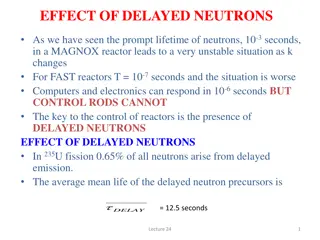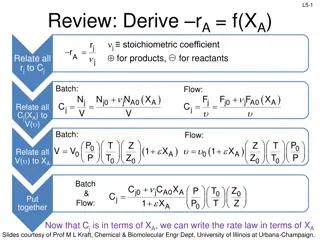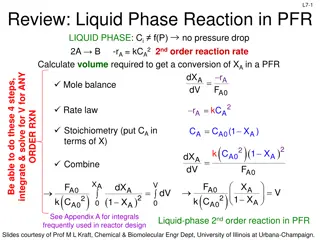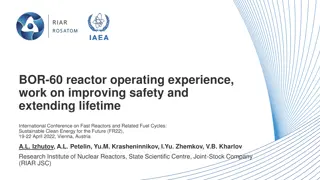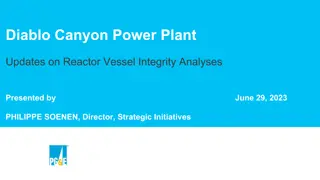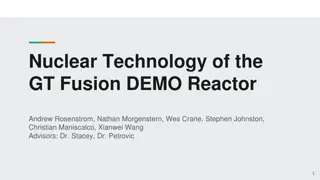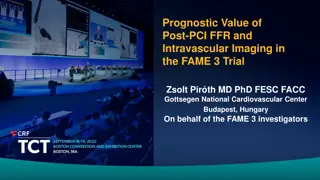Small Modular Reactor Market
The global small modular reactor market was valued at $5.8 billion in 2022, and is projected to reach $13.4 billion by 2032, growing at a CAGR of 8.7% from 2023 to 2032.
5 views • 6 slides
Review: Design Eq & Conversion
Design equations for batch, flow, CSTR, PFR, and PBR systems are discussed, emphasizing the calculation of conversion and reactor volumes. The importance of understanding reaction rates and stoichiometry in determining reactor sizes is highlighted, along with numerical evaluation techniques for inte
0 views • 25 slides
OCTIVUS Randomized Clinical Trial: OCT-Guided vs IVUS-Guided PCI
The OCTIVUS Randomized Clinical Trial compared the clinical efficacy and safety of Optical Coherence Tomography (OCT)-guided and Intravascular Ultrasound (IVUS)-guided strategies in patients undergoing PCI for significant CAD. The study aimed to determine if OCT-guided PCI is noninferior to IVUS-gui
8 views • 27 slides
2024 Vessel Examiner Workshop - Guidelines for Vessel Safety Checks
The 2024 Vessel Examiner Workshop provides essential guidance for both USCG Auxiliary and US Power Squadrons Vessel Examiners. Topics covered include safety considerations, workshop requirements, and the importance of education over enforcement in conducting Vessel Safety Checks. The workshop emphas
7 views • 30 slides
Aspen Simulation of Steam Reforming and Haber-Bosch Processes in Kinetics Reactors
Aspen simulation showcases the kinetics reactors for steam reforming of natural gas and the Haber-Bosch process for ammonia production. Steam reforming is highly endothermic, producing hydrogen and CO, while the Haber-Bosch process is exothermic, crucial for ammonia synthesis. The RPlug reactor and
4 views • 26 slides
Mechanically Driven Biodiesel Reactor for Village-Level Production
This project introduces a mechanically-driven biodiesel reactor designed to empower older women caregivers in Kenya by utilizing a pedal-operated system for biodiesel production from non-edible oils. The reactor, driven by a treadle sewing machine, aims to provide a sustainable energy solution while
1 views • 18 slides
Understanding Reactor Campaign in Nuclear Power Operations
Reactor campaign in nuclear power operations is crucial for ensuring safe and efficient reactor power operation. It involves managing reactivity margin, fuel residence time, nominal power, and effective days of operation. Reactor campaigns are influenced by various factors such as fuel elements' res
1 views • 64 slides
Understanding the Role of Delayed Neutrons in Reactor Control
Delayed neutrons play a crucial role in controlling nuclear reactors by providing a means to adjust reactivity. These delayed neutrons, emanating from fission processes in 235U, have a longer mean lifetime compared to prompt neutrons. This characteristic allows for a more manageable reactor operatio
0 views • 15 slides
Celebrating the Legacy of Magnox Reactors at Wylfa Nuclear Power Station
Explore the rich history and contributions of Magnox reactors at Wylfa Nuclear Power Station, from their pioneering role in electricity generation to the upcoming closure of the last reactor. Join us for insightful discussions on reactor design, waste management, and the future of nuclear energy. Di
0 views • 8 slides
Reactor Sizing and Conversion in Chemical Engineering
This chapter explores the sizing of Continuous Stirred Tank Reactors (CSTR) and Plug Flow Reactors (PFR) using conversion values and overall conversion. It covers the definition of conversion, batch reactor design equations, design equations for flow reactors, and more. The content delves into the m
0 views • 17 slides
Cutting-Edge Installation Vessel Designs and Challenges in Offshore Wind Farms
Explore innovative vessel designs utilized in offshore wind farm installations, along with challenges faced in the industry. Discover key partners, vessel concepts, operational phases, and strategies to enhance efficiency and reduce costs. Overcome obstacles related to turbine installation, weather
0 views • 20 slides
United States Coast Guard Auxiliary Vessel Examiner Workshop 2019
The United States Coast Guard Auxiliary conducted the 2019 Vessel Examiner Workshop focusing on the Vessel Safety Check (VSC) program, the importance of becoming a Vessel Examiner, workshop objectives, general information for Vessel Examiners, and VE currency requirements. The program aims to promot
0 views • 48 slides
United States Coast Guard Auxiliary 2014 Vessel Examiner Workshop
The United States Coast Guard Auxiliary's 2014 Vessel Examiner Workshop focuses on educating Vessel Examiners to enhance boating safety and ensure compliance with safety regulations. The workshop covers VSC procedures, conducting safety checks, and operational facilities for paddle crafts. It includ
1 views • 111 slides
United States Environmental Protection Agency (EPA) Clean Water Act Vessel Discharge Obligations Overview
Brief overview of the Clean Water Act (CWA) requirements for vessel discharge obligations under the National Pollutant Discharge Elimination System (NPDES) permitting program. Includes details on the Vessel General Permit (VGP), permit coverage, discharge types, effluent limits, and implementation s
0 views • 18 slides
Reactor Sizing: Conversion, Selectivity, and Kinetics Overview
Understanding reactor design involves considerations such as desired conversion, selectivity, and kinetics. Key concepts include rate laws, molar balances, and reactor types. Through molar balance equations and reactor design processes, one can derive essential equations for ideal batch, CSTR, and P
2 views • 20 slides
Fundamentals of Chemical Kinetics and Reactor Design
Explore the realm of chemical reactions, rate equations, and reactor design in this informative chapter. Understand the factors influencing reaction rates, different types of reactions, rate laws, and experimental determination of reaction rates. Dive into examples illustrating stoichiometry and rat
0 views • 19 slides
Chemical Reactor Design Principles
Explore the fundamentals of chemical reactor design, including stoichiometry, reaction rates, and reactor scale-up. Learn to derive rate laws and design equations in terms of conversion for batch, CSTR, and PFR reactors. Discover the logic behind isothermal reactor design and calculation of required
0 views • 21 slides
Reactor Design Principles for Liquid and Gas-Phase Reactions
This material covers the design principles for liquid and gas-phase reactions in continuous flow reactors such as PFR (Plug Flow Reactor) and PBR (Packed Bed Reactor). It includes calculations for volume required to achieve a specific conversion, catalyst weight needed, and considerations for ideal
0 views • 21 slides
Understanding Reactors in ChemCAD: Models and Examples
ChemCAD offers various reactor models such as stoichiometric and equilibrium reactors for simulating chemical processes. Engineers can choose the appropriate model based on the reaction type and accuracy needed. Explore different reactor types through examples and process flow diagrams to enhance yo
0 views • 21 slides
BOR-60 Reactor Operating Experience and Design Configuration
The BOR-60 reactor, a key component of sustainable clean energy, has a rich history since its construction in the USSR. Its design configuration includes various components such as coolant inlet nozzles, control rod mechanisms, and fuel loading ducts. The core arrangement consists of control rods an
0 views • 12 slides
Understanding Reactor Start-up and Neutron Multiplication in Subcritical Reactors
Reactor start-up is a crucial operation that transitions a reactor from a subcritical state to a critical state by carefully adjusting reactivity levels. In a subcritical reactor, the neutron density should decrease over time but may not reach zero due to certain factors. Neutron multiplication fact
0 views • 66 slides
Machine Learning for Molten Salt Reactor Safeguards
Molten salt reactors face challenges in material accounting due to liquid fuel which precludes traditional safeguards. This project proposes a two-step approach involving the development of measurement signatures created by material diversion, and a machine learning model to distinguish normal react
1 views • 18 slides
Chemical Reactor Design: Rates, Mechanisms, and Reactor Types
The field of chemical reactor design encompasses studying reaction rates, mechanisms, and designing reactors for various processes. Factors such as reaction type, production scale, cost, safety, and more influence the choice of reactor scheme. Understanding reactor systems and applying engineering j
1 views • 15 slides
Ammonia Reactor System Design and Optimization Study for High Efficiency
This material discusses the design and optimization of an ammonia synthesis reactor system for maximizing conversion efficiency while minimizing CAPEX costs. Various factors such as managing heat effects, reaction runaway prevention, and cooling profiles are explored. Recommendations include using a
3 views • 10 slides
Overview of Chemical Reactor Design and Operation
Chemical reactor design involves studying the rates and mechanisms of chemical reactions, as well as the design of reactors for these reactions on a commercial scale. This field combines principles from thermodynamics, chemical kinetics, fluid mechanics, mass transfer, heat transfer, and economics t
0 views • 12 slides
Diablo Canyon Power Plant Reactor Vessel Integrity Analyses Update
Updates on Diablo Canyon Power Plant's reactor vessel integrity analyses were presented by Philippe Soenen, Director of Strategic Initiatives, on June 29, 2023. The analysis includes background information, reactor vessel surveillance coupon withdrawal plans, and the request for Nuclear Regulatory C
0 views • 9 slides
Advancements in Fusion Reactor Technology: A Comprehensive Overview
This presentation delves into the nuclear design aspects, objectives, background, and state-of-the-art components of the GT Fusion DEMO Reactor project. It covers key areas such as tritium breeding ratio, neutron transport, temperature distribution, and material choices for optimal reactor performan
0 views • 31 slides
Tracer Study for Reactor Pressure Vessel: Overview
Detailed information about a tracer study conducted on a reactor pressure vessel with a volume of 20,000 gallons. The study includes data on the vessel's dimensions, baffling configuration, tracer test results, sample locations, analysis methods, and more. Insights into the tracer test purpose, disi
0 views • 16 slides
Prognostic Value of Post-PCI FFR and Intravascular Imaging in FAME 3 Trial
This study investigates the prognostic value of measuring post-PCI Fractional Flow Reserve (FFR) and intravascular imaging in patients with complex 3-vessel coronary artery disease (CAD), focusing on the impact on outcomes such as target vessel failure (TVF), including cardiac death, target vessel m
0 views • 15 slides
Overview of 2019 Amendments to the Croatian Maritime Code
The 2019 amendments to the Croatian Maritime Code aimed to enhance the competitive strengths of Croatian shipping, improve seafarers' positions, reduce administrative barriers, digitize the shipping sector, and harmonize with EU legislation. Key topics covered include vessel definitions, safety, sea
0 views • 15 slides
Enhancing Boating Safety Through Vessel Examiner Training Programs
Engage in boating safety with the public by becoming a Vessel Examiner (VE) and conducting Vessel Safety Checks (VSC). Learn how to ensure recreational vessels meet legal safety requirements and raise boater awareness. The process includes VSCs, Vessel Registration, VE qualifications, and participat
0 views • 27 slides
Compact Muon Radiography System for Investigation of Nuclear Reactor Fuel Status
A seminar presentation at LAL on May 23, 2013, discussed a compact muon radiography system designed for investigating the status of nuclear reactor fuel. The system, developed by researchers from the University of Tsukuba, involved the use of trackers with scintillators and muon detectors at various
0 views • 56 slides
Understanding Blood Vessel Leakiness Control Mechanisms
Blood vessel leakiness, a common feature in diseases like inflammation, metastasis, and viral hemorrhagic infections, is controlled by factors such as Angiopoietins and the Tie-2 pathway. Activation of Tie-2 leads to increased vessel diameter, allowing the transfer of white blood cells, while deacti
0 views • 16 slides
Reactor Xenon Poisoning and Iodine Pit Phenomenon
When a non-stationary reactor is shut down or its load is reduced to zero, xenon poisoning occurs due to the disruption of dynamic equilibrium between the increase and decrease of 135Xe. This leads to a temporary increase in 135Xe concentration, followed by a decrease as it decays. The reactivity ma
0 views • 58 slides
Chemical Reactor Design: Unsteady State and Nonisothermal Reactors
Developing energy balances for unsteady state and nonisothermal reactors is essential for designing efficient chemical reactors. The energy balances involve terms such as heat flow, work done, energy accumulation, and mass flow, which impact the reactor's performance. By considering factors like pha
0 views • 29 slides
Introduction to Chemical Reaction Engineering
Chemical Reaction Engineering (CRE) is crucial for understanding how chemical reactors operate in various processing operations. This field involves reactor design by integrating factors such as thermodynamics, kinetics, fluid mechanics, heat transfer, and economics. CRE aims to effectively design a
0 views • 16 slides
Understanding Blood Clots, Vessel Blockage, and Strokes
Polymers, blood clots, vessel blockages, and strokes are explained in this informative content. Blood clot formation, vessel blockages due to embolism and thrombosis, and the different types of strokes are detailed. The effects of stroke on the brain and its various regions are highlighted.
0 views • 11 slides
Review of Chemical Reactor Design Concepts and Numerical Integration Methods
This presentation covers various topics related to chemical reactor design, including batch systems, flow systems, ideal reactor design equations, CSTRs, PFRs, and PBRs. It also discusses the numerical evaluation of integrals using different methods such as Simpson's rules. Slides courtesy of Prof.
0 views • 25 slides
Overview of Boiler and Pressure Vessel Technical Sub-Council Updates
Explore updates from the Boiler and Pressure Vessel Technical Sub-Council for the 2014/15 business year. Includes information on council structure, regulatory frameworks, significant changes, and working groups addressing various issues in the field. Discover the role of the council in ensuring safe
0 views • 23 slides
Reactor Design Fundamentals: Rate Laws and Analysis
This content covers the analysis of pressure drop in packed bed reactors, determining reaction order, and studying rate data for reactor design. It delves into stoichiometry, kinetics, fluid dynamics, and the challenges of collecting and analyzing rate data. Examples of rate laws and reactions are p
0 views • 32 slides







